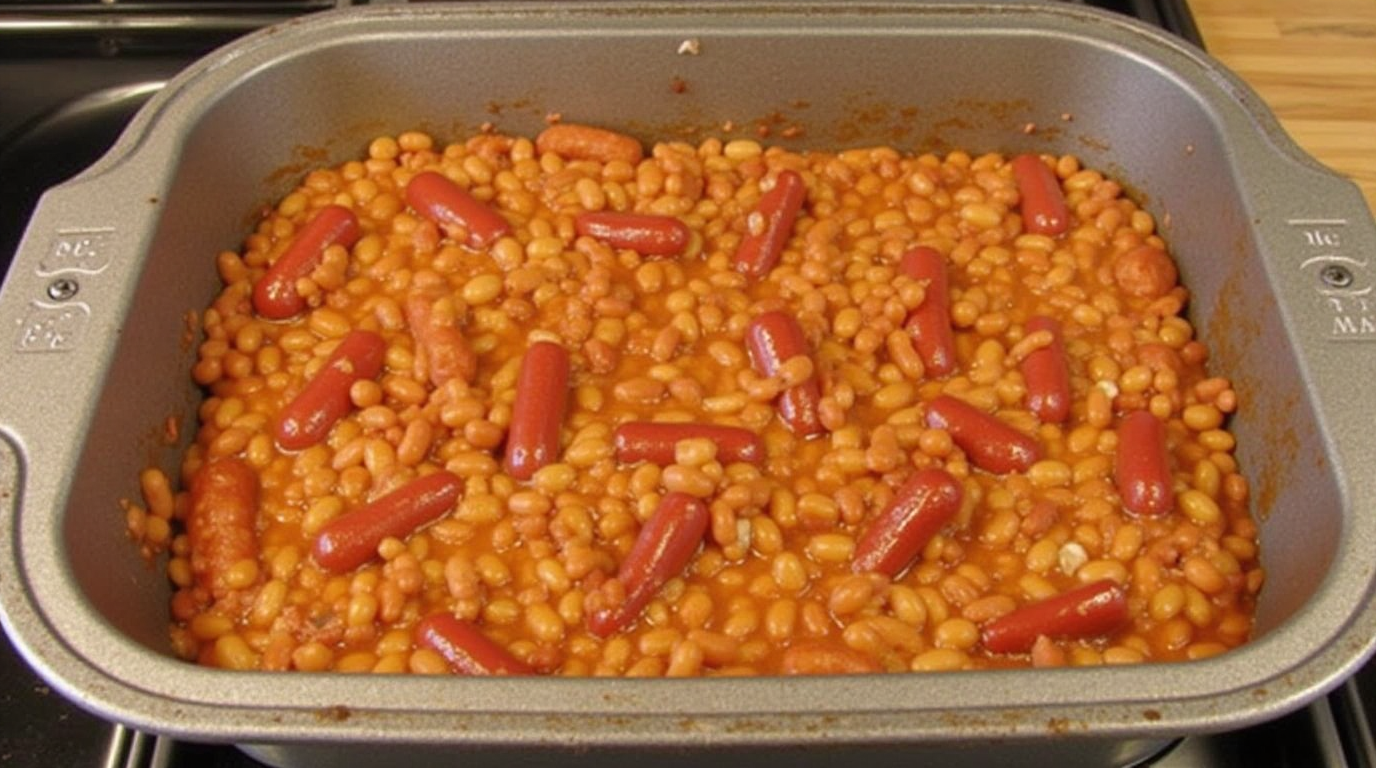Discover the delicious history, ingredients, and how to make beanie weenies—a timeless comfort food loved by many.
Beanie weenies have long been a beloved comfort food, offering simplicity, warmth, and satisfaction in every bite. Whether served as a quick meal for busy nights or enjoyed as a nostalgic dish from childhood, this classic recipe combines two staple ingredients—beans and hot dogs—into a filling and flavorful dish. In this article, we’ll explore what beanie weenies are made of, the best ways to prepare them, and some tasty variations.
What Are Beanie Weenies?
Beanie weenies, also known as “beans and weenies” or “franks and beans,” is a dish primarily made up of baked beans and sliced hot dogs (or “weenies”). It’s a quick, satisfying meal that can be easily modified with various seasonings, vegetables, and spices to suit your taste. Typically, it’s a dish that’s popular with children due to its simple and mildly sweet flavors, but adults can appreciate it as well for its ease of preparation and nostalgic qualities.
The History of Beanie Weenies
While beanie weenies are commonly associated with American comfort food, the exact origins of the dish are unclear. It’s widely believed that the combination of beans and hot dogs dates back to the Great Depression when families needed inexpensive, filling meals. The dish has evolved over the years, with many variations emerging across different regions and households.
In fact, Beanee Weenee is also a well-known canned food brand that has popularized the dish in pre-made, convenient form. The brand’s history dates back to 1960, providing an easy way for people to enjoy this classic meal without having to cook from scratch.
Ingredients in Beanie Weenies
The core ingredients of beanie weenies include:
- Hot Dogs (Weenies): The main protein, cut into bite-sized pieces, which gives the dish its savory flavor.
- Baked Beans: Often used from a can, they provide the sweet and savory base for the dish.
- Seasonings: Commonly, salt, pepper, and a little bit of brown sugar or molasses are used to enhance the flavor profile. Some people may also add mustard, ketchup, or chili powder for a tangy kick.
- Optional Additions: Ingredients like onions, bell peppers, bacon, or even cheese can be added to elevate the flavor of the dish.
Although the base ingredients are simple, beanie weenies can be made into a more sophisticated dish with the right tweaks.
How to Make Beanie Weenies
Making homemade beanie weenies is incredibly easy, and you can modify the recipe based on your preferences. Here’s a simple recipe to try:
Ingredients:
- 4 hot dogs (we recommend using beef or turkey hot dogs for a healthier option)
- 2 cans of baked beans (about 15 ounces each)
- 1 small onion, finely chopped (optional)
- 1/2 cup of ketchup
- 1 tablespoon of brown sugar
- 1 teaspoon of mustard
- Salt and pepper to taste
Instructions:
- Prepare the Hot Dogs: Slice the hot dogs into bite-sized pieces. You can use a sharp knife to cut them into rounds or quarter them lengthwise for smaller pieces.
- Cook the Hot Dogs: In a large skillet, cook the hot dog slices over medium heat for 5-7 minutes or until lightly browned. This adds extra flavor to the dish.
- Add the Beans: Pour the baked beans into the skillet with the cooked hot dogs. Stir to combine.
- Season the Dish: Add the ketchup, brown sugar, mustard, salt, and pepper to the skillet. Stir everything together. Let the dish simmer for 5-10 minutes to allow the flavors to meld.
- Serve: Once the beans are heated through and the flavors are well combined, taste and adjust the seasoning if needed. Serve warm with cornbread or over rice.
Serving Suggestions
When it comes to serving beanie weenies, the right accompaniments can transform this simple, hearty dish into a well-rounded meal or a festive spread. Here are a few serving suggestions:
- Classic Comfort Pairings:
- Cornbread: Serve a warm slice of cornbread to soak up the sweet, savory sauce.
- Coleslaw: A crisp, tangy coleslaw helps cut through the richness of the beans and hot dogs.
- Potato Salad: A cool, creamy potato salad provides comforting familiarity and pairs well with the smoky-sweet flavors.
- Light and Fresh Sides:
- Green Salad: A simple green salad with a light vinaigrette adds freshness and nutrients.
- Roasted Vegetables: Grilled or roasted vegetables—such as zucchini, bell peppers, or cherry tomatoes—offer brightness and texture contrast.
- Whole Grain Options:
- Whole-Grain Rolls or Buns: Scoop the mixture into a bun for a quick sandwich, or use rolls to create mini sliders.
- Brown Rice or Quinoa: Spoon the beanie weenies over a bed of grains for a more substantial, fiber-rich meal.
- Kid-Friendly Ideas:
- Mac and Cheese: Pair with creamy mac and cheese for a kid-approved comfort feast.
- Carrot Sticks and Apple Slices: Add some crunchy, colorful produce for a balanced plate.
- Creative Presentations:
- Toppings Bar: Offer shredded cheese, diced onions, pickled jalapeños, or fresh herbs so everyone can customize their serving.
- Bread Bowl: Hollow out a crusty bread loaf and fill it with beanie weenies for a fun party centerpiece.
These suggestions help you tailor the meal to your preferences—whether you’re looking for a quick, budget-friendly dinner, a backyard barbecue crowd-pleaser, or a nostalgic family meal.
Variations of Beanie Weenies
While the traditional beanie weenies recipe is delicious on its own, there are many ways to change it up to suit your taste.
1. Add Bacon for Extra Flavor
Bacon adds a smoky, crispy element to the dish that complements the beans and hot dogs perfectly. Simply cook the bacon until crispy, chop it up, and stir it into the dish.
2. Spicy Beanie Weenies
For those who like a little heat, adding diced jalapeños, chili powder, or hot sauce can make the dish more exciting. This variation adds a kick while still maintaining the comforting base flavors.
3. Vegetarian Beanie Weenies
If you’re vegetarian or looking to reduce your meat intake, you can substitute the hot dogs with plant-based sausages or even use lentils as a protein substitute. This version is just as filling and tasty.
4. BBQ Beanie Weenies
Add a smoky twist to your beanie weenies by mixing in some barbecue sauce instead of ketchup. The tangy flavor from the BBQ sauce pairs wonderfully with the beans and hot dogs.
Beanie Weenies and Its Popularity in the U.S.
Beanie weenies are often associated with American culture, particularly in southern and rural areas. The dish is perfect for family gatherings, school lunches, or even campfire meals. Additionally, it’s a staple in many households due to its low cost and ease of preparation.
Moreover, beanie weenies have become a comfort food symbol, often evoking memories of simpler times and childhood meals. This nostalgia, combined with the dish’s versatility, is why it remains popular today.
Nutritional Value of Beanie Weenies
While beanie weenies are undoubtedly delicious, they can be somewhat high in sodium and calories, particularly when using canned baked beans and hot dogs. However, by using healthier alternatives—such as low-sodium beans and turkey or plant-based hot dogs—you can make this dish a more nutritious option.
Here’s a general breakdown of the nutritional content (per serving):
- Calories: Approximately 250-350 calories
- Protein: 10-15 grams
- Carbohydrates: 25-30 grams
- Fat: 10-15 grams (depending on the type of hot dogs and beans used)
- Fiber: 5-7 grams
To reduce the calorie count, consider serving the dish with a salad or a side of steamed vegetables to balance it out.
Sustainability, Storage, and Reducing Waste
On to the following discussion, consider sustainability. Use leftover beanie weenies as a topping for baked potatoes or a filling for tacos. Store leftovers in airtight containers. Refrigerate for up to a few days or freeze for longer storage. Reheat gently to preserve texture.
Heading into the subsequent area, choosing local beans and ethically sourced sausages supports small farmers. Buying in bulk reduces packaging waste. Compost vegetable scraps from any added aromatics. Simple changes make the dish more eco-friendly. By repurposing leftovers or using seasonal produce, you help build a more sustainable kitchen.
Common Problems and Troubleshooting
In the next subsection, solve common issues. Too sweet? Stir in a tablespoon of apple cider vinegar or a spoonful of mustard. Too salty? Add more beans or water, or toss in a few plain mashed beans to dilute sodium. Too watery? Simmer uncovered longer or add tomato paste.
In the succeeding section, bland flavor? Spice it up with chili powder, smoked paprika, or a dash of hot sauce. If texture is off, experiment with cooking times or bean varieties. Plant-based sausages vary in flavor, so adjust seasoning accordingly. Patience and small tweaks lead to perfect beanie weenies every time.
Frequently Asked Questions (FAQ)
Moving forward to the next topic, let’s address common queries.
What is beanie weenies made of?
Beanie weenies typically combine sweet, saucy baked beans with sliced hot dogs or franks. Often, simple condiments like ketchup, mustard, and brown sugar enhance the flavor. Aromatics like onions or garlic can add depth.
What do you eat with beanie weenies?
Pair them with classic sides like cornbread, coleslaw, or potato salad. Crisp green salads or grilled vegetables add freshness. They also work well with mac and cheese or as a filling for sandwiches.
When did Beanee Weenee come out?
Campbell’s introduced its branded “Beanee Weenee” in the 1960s. During that era, convenience foods soared in popularity. Families embraced ready-to-eat meals that simplified dinnertime.
Who came up with beanie weenies?
While the exact originator is unclear, the concept evolved naturally as Americans combined beans and franks. Over time, companies and home cooks refined recipes. The dish’s popularity grew through word-of-mouth and advertising.
Conclusion
Transitioning into the following chapter, reflect on the enduring appeal of beanie weenies. This dish, though simple, carries significant cultural weight. Generations remember it fondly. By tweaking ingredients and methods, you can tailor it to any lifestyle or taste.
Consider its role as a budget-friendly, quick option in a busy world. From humble canned beans to gourmet twists, beanie weenies adapt and persist. Its comforting flavors and nostalgic charm promise a timeless place in American kitchens.
Recall that personalization is key. Adjust flavors to your liking, add spices, or try vegan options. Serve it at a potluck, a family dinner, or a casual camping trip. No matter how you present it, beanie weenies bridge generations with warmth and simplicity.
As you explore variations, you preserve a piece of culinary heritage. Beanie weenies stand the test of time, proving that sometimes the simplest dishes bring the greatest comfort. Keep experimenting and enjoy this enduring classic for years to come.

